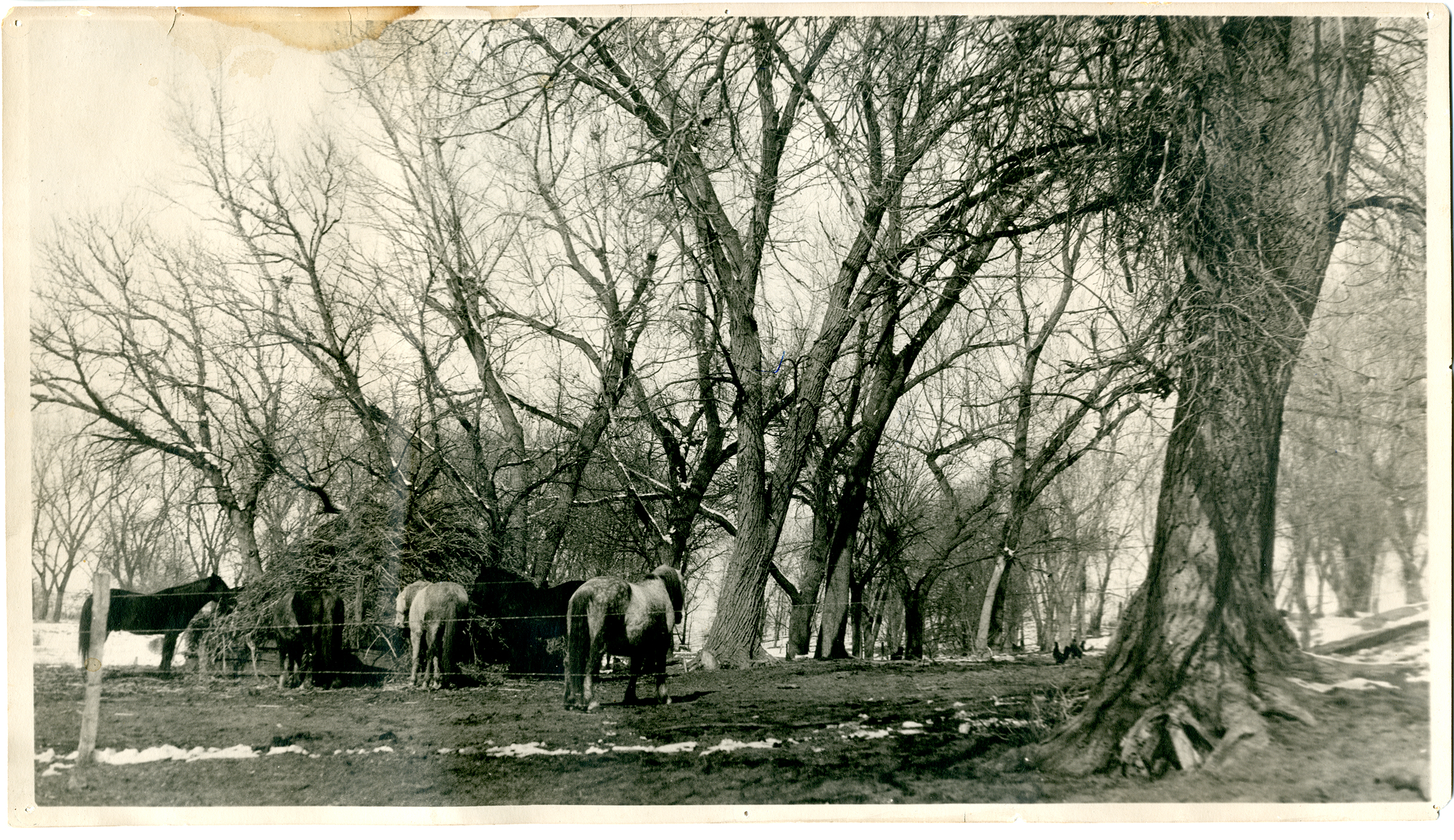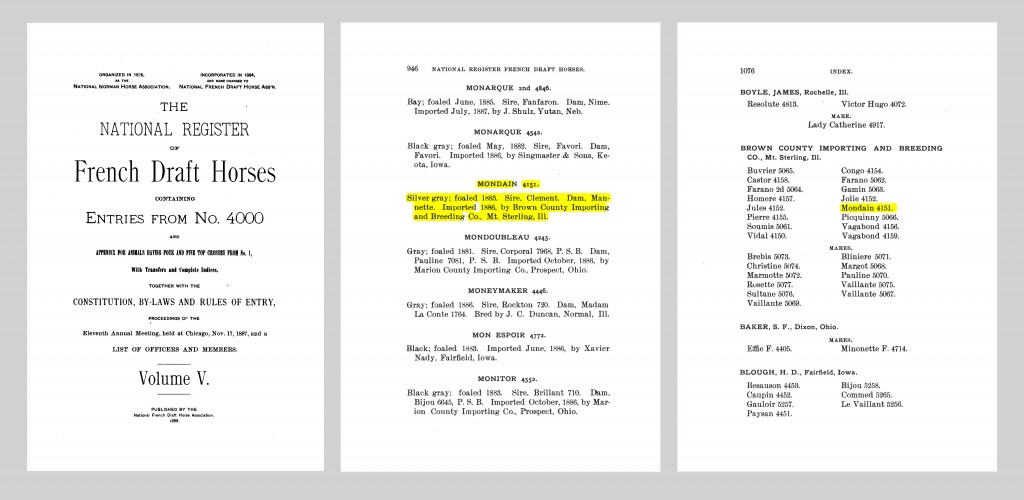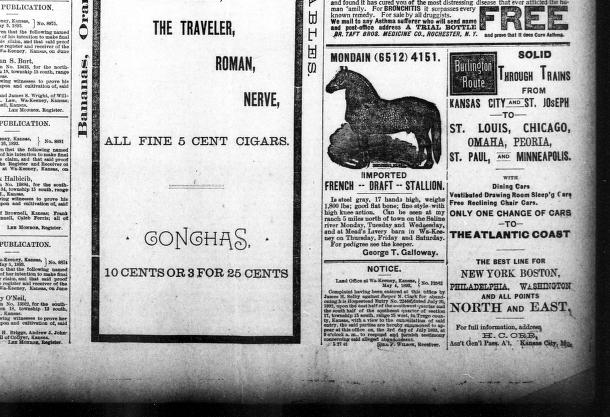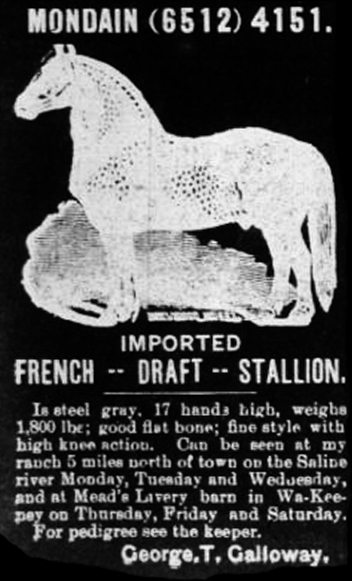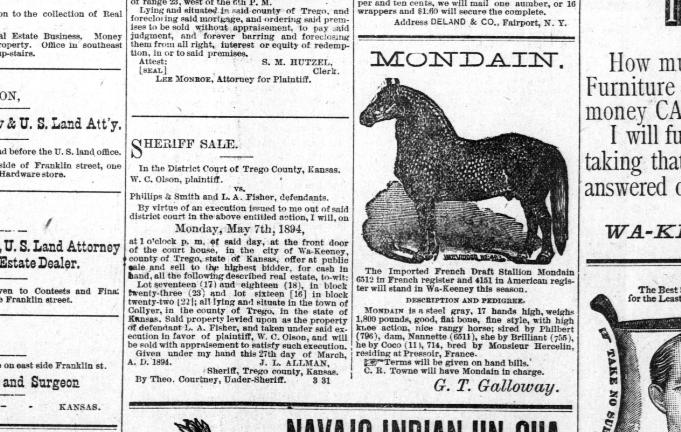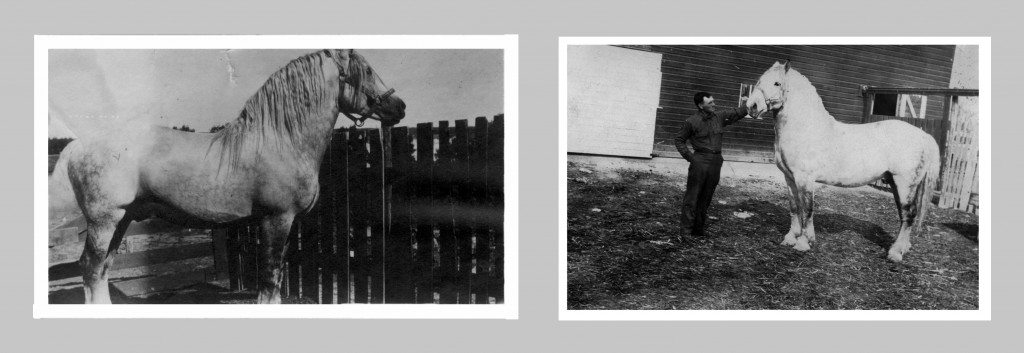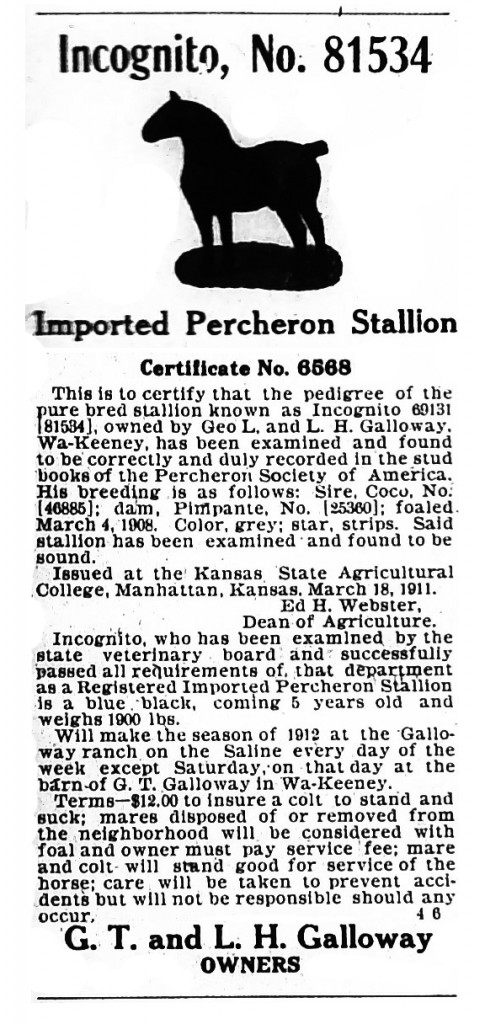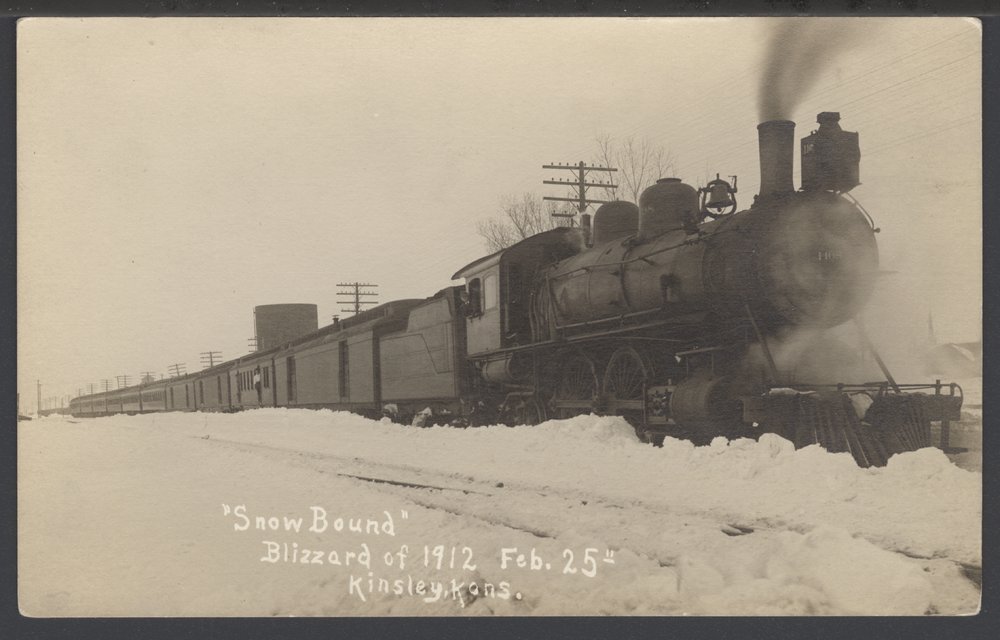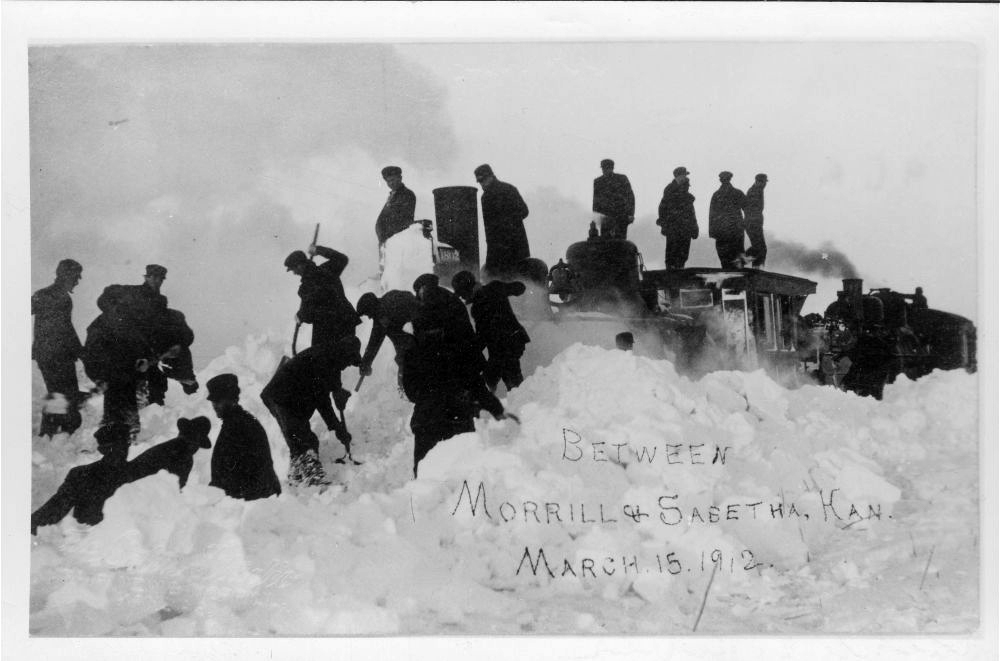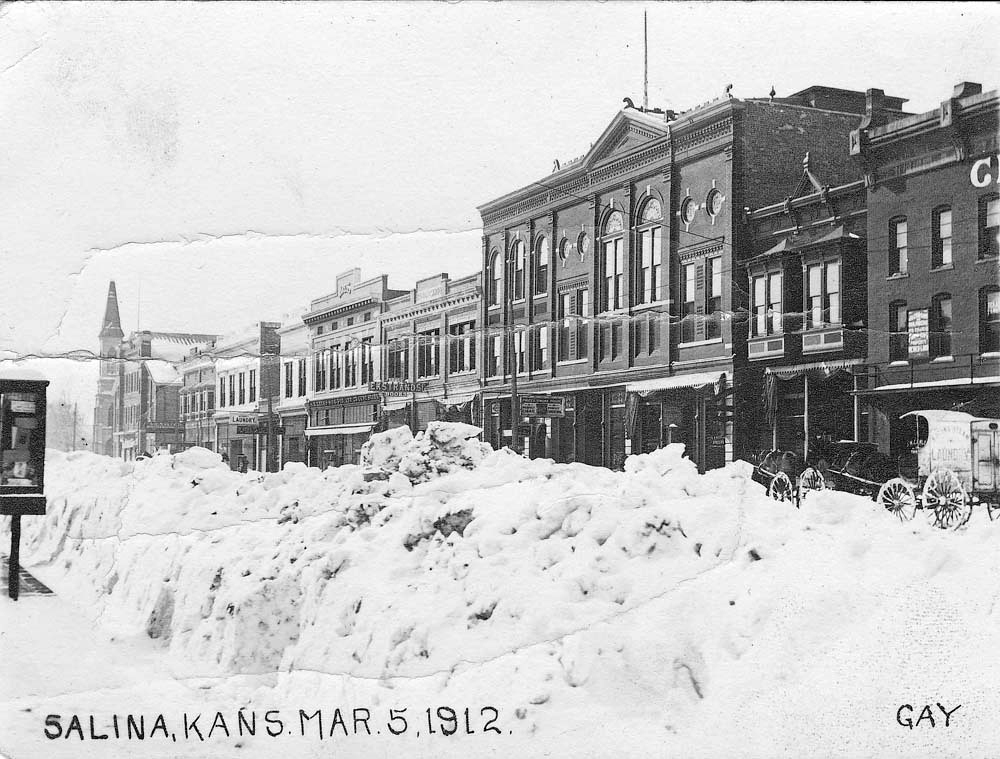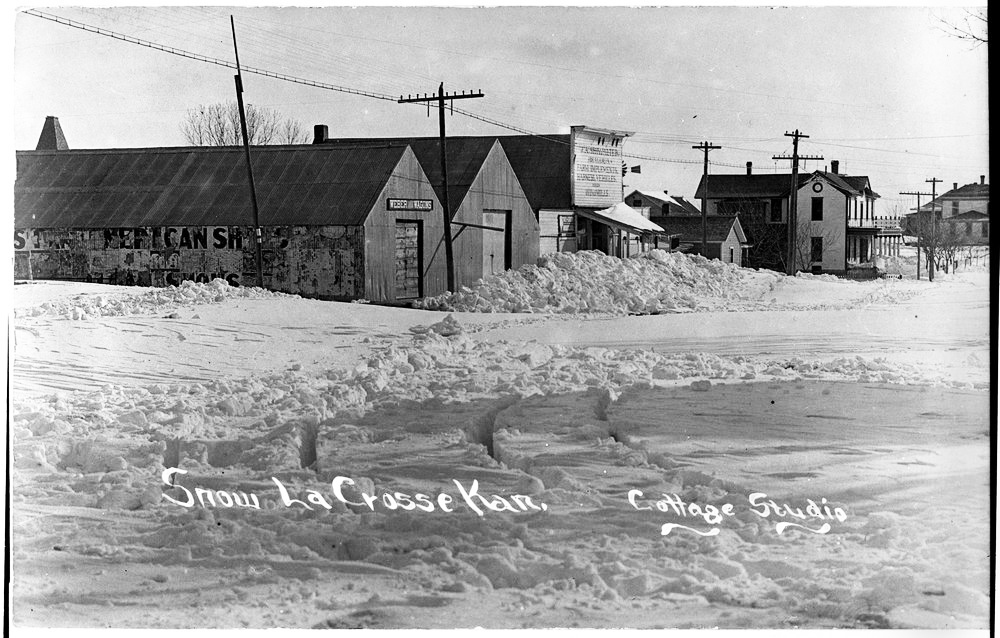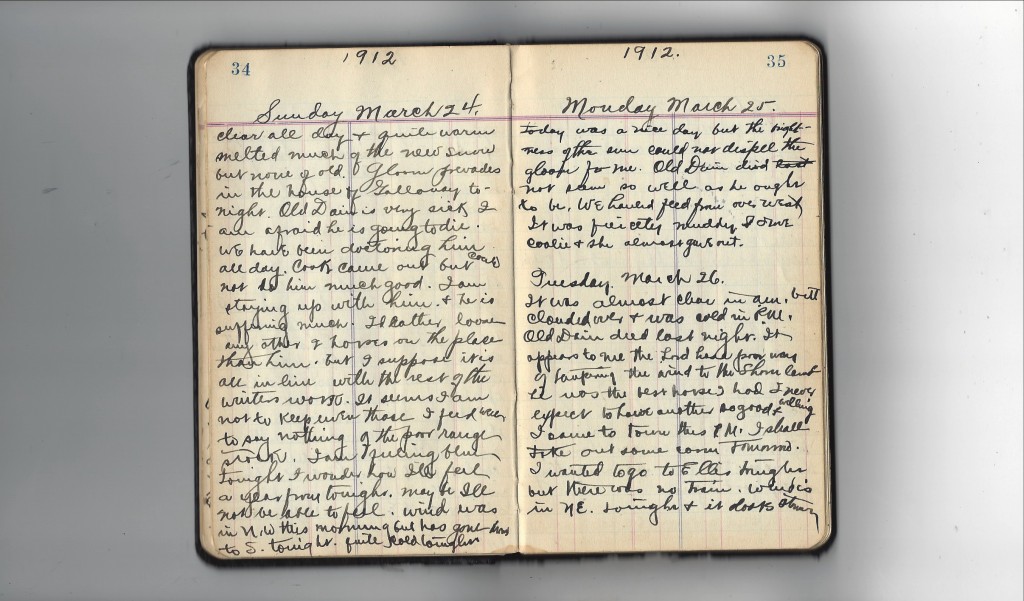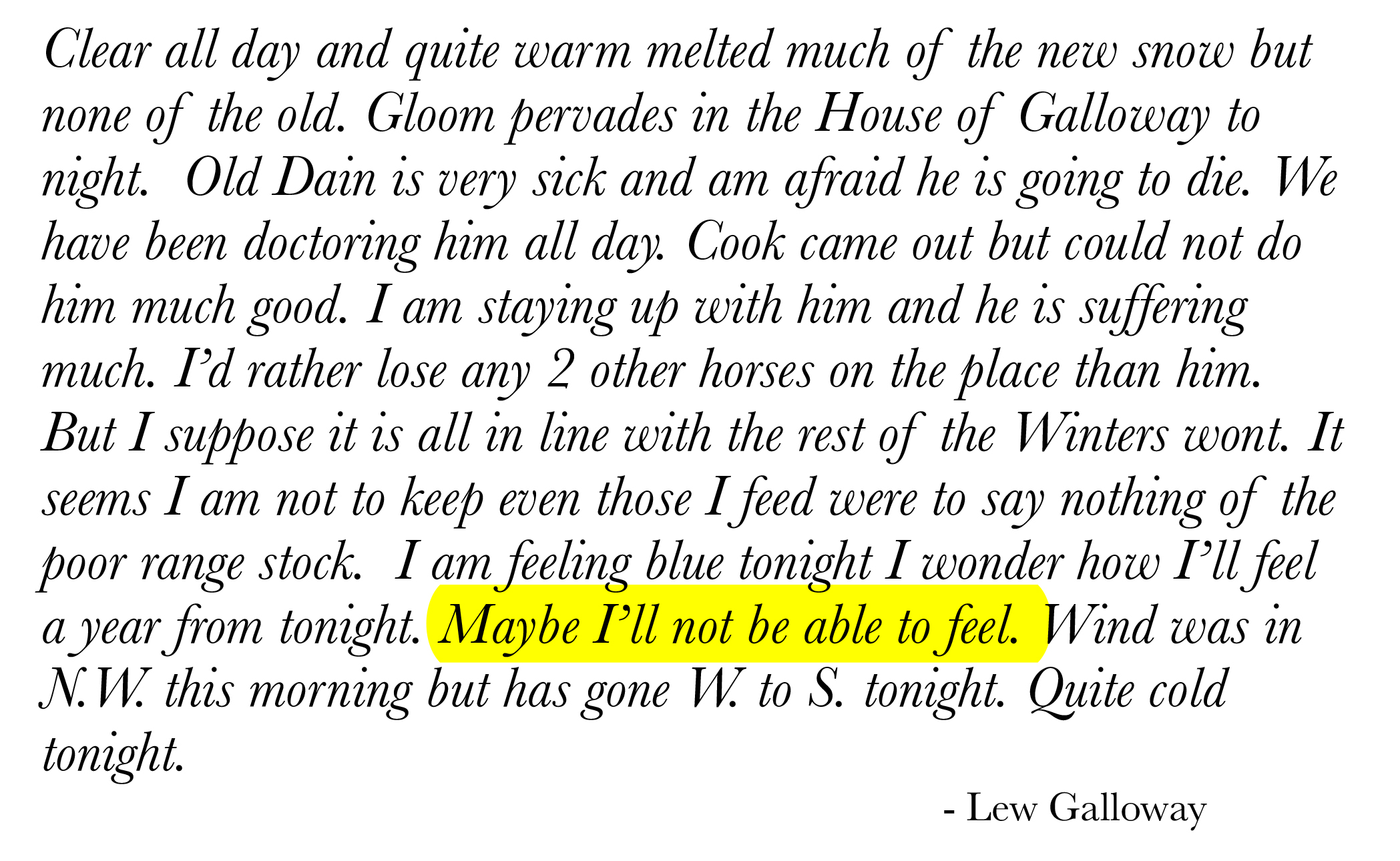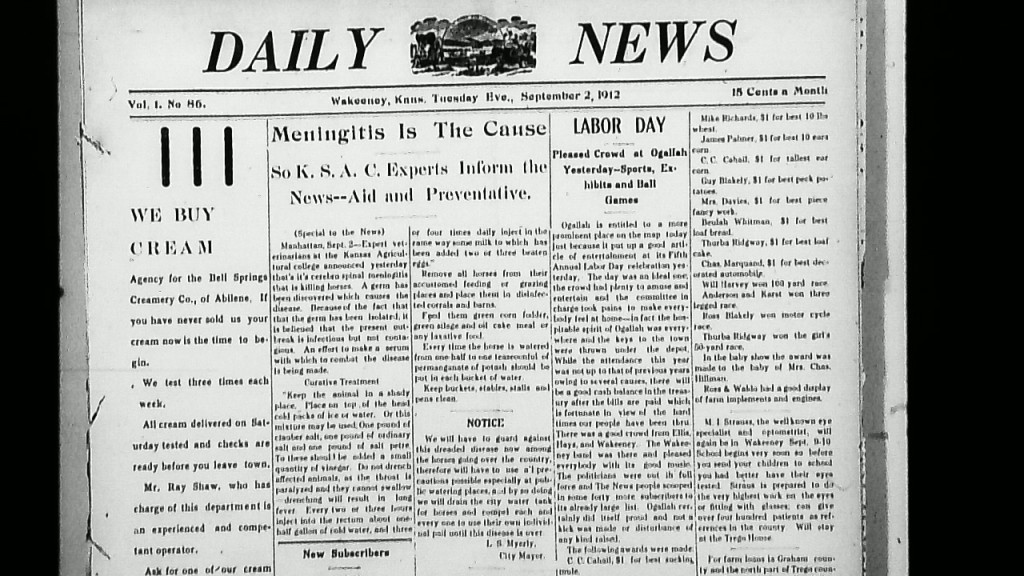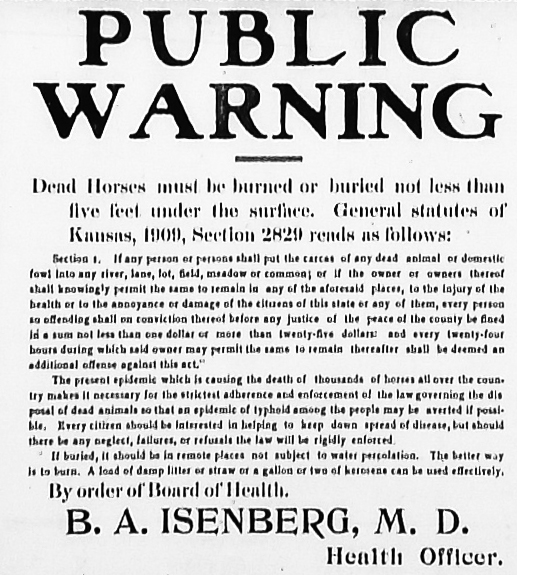This was the best horse that my Great-Great-Grandfather George Thomas Galloway ever had. MONDAIN (pronounce mon-don) was a Percheron stallion that was on my family farm more than 100 years ago. The horse was purchased by my pioneering great great grandfather sometime between 1886 and 1891, at which time he started to advertise the horse as ‘for hire’ for breeding in western Kansas. “Old Dain” was an important part of daily life for George, Lew and their families for more than 20 years. The significance and importance of the animal to these men is evident by reading the diary entries of Lew H. Galloway, especially the entries from March 1912.
Mondain is the horse in the foreground above, the silver dappled horse on the right. I’ve been stalking this horse for the better part of a decade. In the flotsam and jetsam of my father’s office was the photograph above, framed by Lew decades before. It’s the only photo of the horse that I have. It was taken in what was called the “Mulberry Grove” that Great-Great-Grandfather George Thomas Galloway started planting on his homestead in 1881. On the back of the photo in pencil was Lew’s handwriting, “Old Dain”. Lew wrote about the horse in his 1912 diary. Over the years I have scoured out-of-print books, scanned books and registries available in the internet, railroad schedules and US Census and State of Kansas census records from the years 1880-1915. I’ve visited state and county historical societies. I have gone through hundreds of yards of microfilm and microfische, pouring through 6 different newspapers, reading the news and classifieds from the years 1883 to 1912 in the states of Kansas and Illinois.
I still only have the one photo.
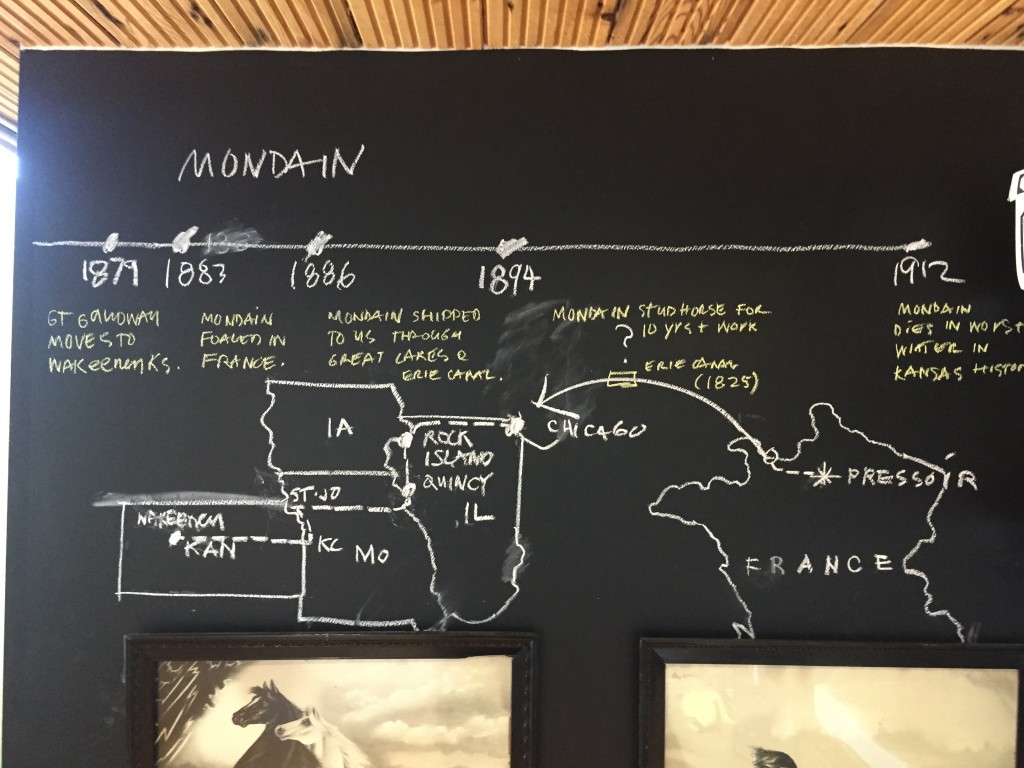
Using 125 year old train schedules and studying major routes of livestock and goods transported west from the Mississippi River, a most likely route of passage to western Kansas was determined.
The Percheron stallion is a descendent of the war horse of ancient times. They are of Arab lineage, supposedly brought to Europe by the Moors in the middle ages. They are usually black or grey in color and can weigh as much as 2,600 lbs. They are grand and beautiful animals. The name stems from a region of France called LE PERCHE. The men from Le Perche have always been renowned for their horsemanship not as purchasers and traders of these stallions, but as breeders of a particular breed. The men of Le Perche were some of the best horsemen on the planet:
“Their horses are a part of their inheritance, particularly prized and accustomed to the affectionate attention of the entire household. Their docility, growing out of their intimate human relationship, is therefore an inborn trait“.
– Alvin Sanders, from A History of The Percheron Horse (1917)
They are an old breed of French draft horse that were very popular as imported stock into the US and Canada, from before the second industrial revolution and the expansion of the railroad to end the of World War 2, when their numbers in the US began to decline. Importation of the breed began in 1839. In the 1880’s, more than 5,000 Percheron stallions were imported to North America (2). Prior to the railroad expansion to the West, they along with Clydesdale horses were the primary workhorses and catalysts for the westward expansion of the United States. They were shipped BY rail to territories west of the Mississippi, and used for farming and general labor in industrial cities as they literally provided the horsepower that Manifest Destiny required. In the 1930 US Census, 70% of the draft horses in the US were of Percheron lineage, and more than 10,000 Percherons a year were imported into the US through the 1950’s.
MONDAIN
He was a Percheron stallion licensed with the National Register of French Draft Horses (1) with the following description:
MONDAIN 4151. Silver Gray; foaled 1883. Sire, Clement. Dam, Manette. Imported 1886 to American by the BROWN COUNTY IMPORTING & BREEDING CO., Mt. Sterling, Illinois
Mondain was one of 16 horses imported from France by the company that year. The Brown County Importing and Breeding company was one of the largest importers of draft horses in the United States at that time, as development along the Mississippi River increased. Mt. Sterling is 200 miles from Quincy, Illinois where George lived prior to 1879 when he emigrated to Trego County, Kansas.
George bought the horse between 1886 after the horse was brought by steamship from France, and the year 1891, though I do not have an exact date. 1891 is the date that Mondain started to become listed as a stud for hire in the classified advertisement section of the Western Kansas World from 1891-1894 and other local papers for hire (2,3).
This is an advertisement for services to be rendered by the stallion, listed by George Galloway. The newspaper is the Western Kansas World dated August 1891 and the advertisements ran in late summer every week for 12 weeks straight. This coincides with foaling season starting after the last frost. The advertisement reads:
A later advertisement from 1894, additional information about the lineage of the horse is offered as proof of his legitimacy:
MONDAIN. The Imported French Draft Stallion Mondain 6512 in French register and 4151 in American register will stand in Wa-Keeney this season.
DESCRIPTION AND PEDIGREE. MONDAIN is a steel grey, 17 hands high, weighs 1,800 pounds, good flat bone, fine style, with high knee action, nice rangy horse; sired by Philbert (795), dam, Nannette (6511), she by Brilliant (755) he by Coco (116, 714) bred by Monsieur Hercelin, residing Pressoir, France.
The Terms will be given on handbills. C.R. Towne will have Mondain in charge.
G.T. Galloway
George’s middle son Lew Hamilton Galloway was born in 1883, the same year as Mondain. Conservatively assuming that George purchased the horse in early 1891, Lew would have been 8 years old and spent his life growing up on the farm with the horse that he affectionately called “Old Dain”. The horses job at this time on the farm would have required long hours and was the primary source of power for hauling, planting, listing, and harvesting all of the various row crops grown on the farm.
In 1912, Mondain would have been 29 years of age, at the end of his time being used as a primary workhorse on the Galloway Ranch. His role as the lead horse has been replaced by a younger Percheron stallion, INCOGNITO. This horse was now the preferred horse stud of choice by George and Lew Galloway, now partners in the ranching and farming business 5 miles north of WaKeeney.
Throughout the entire spring and summer of 1912, George and Lew ran classifieds in the Western Kansas World offering up their prized stallion as stud for hire to local ranchers looking to improve their stock. Incognito was foaled around 1907, based upon the information offered up in the advertisement.
THE WINTER OF 1912
1912 was the year of the worst snowstorm in recorded history in Kansas (4,5,6). A snowstorm in February and on March 23rd of 1912 dumped more than 3 feet of snow throughout Kansas. The railroad through Kansas was shut down for more than 4 days in the late March blizzards.
Many livestock were lost throughout Kansas in the snowstorm and the Galloway Ranch was affected as well, as Mondain fell ill during the storm. His condition was noted in Lew’s diary from March of 1912.
Saturday March 23.
Strong NE. wind all day. Cloudy and cold snowed quite hard all day. Very wet on cattle. Two calves died last night and another cow is down. Today was our unlucky day. We got two loads of alfalfa from H. (Heckman) place and got stuck with both coming home. Then we got a cow down in the mud and a team ran away. Cold and Wet tonight and old Dain is sick. I wanted to go to Ellis but it was too stormy. I wonder when it will ever stop storming.
Sunday March 24.
Monday March 25.
Today was a nice day but the brightness of the sun could not dispel the gloom for me. Old Dain not so well as he ought to be. We hauled feed from over West. It was fiercely muddy and I drove Coalie and she almost gave out.
Tuesday March 26.
It was almost clear in A.M. but clouded over and was cold in P.M. Old Dain died last night. It appears to me the Lord has a poor way of dampening the wind to the Show land (Cannot trans.) He was the best horse I had I never expect to have another so good and willing. I came to town this P.M. I shall take out some corn tomorrow. I wanted to go to Ellis tonight but there was no train. Wind’s in NE. tonight and it looks stormy.
HORSE DISEASE SWEEPS THROUGH KANSAS
The summer of 1912 was also one of the worst livestock die-offs in the history of Kansas. That year a deadly horse meningitis swept through the State of Kansas and many horses died from the disease, or were killed and burned to prevent the disease from spreading to neighboring ranches or communities.
There was a burn order in effect for Trego County and more than 20,000 animals perished in Saline County alone.
During an preliminary analysis of state Census records for Trego County, Kansas for the years 1905 and 1915, horse numbers in the county were down 25% or more in the 1915 Census compared to 10 years earlier. Because state census are taken every 10 years in the off-interval (1905, 1915, 1925) between Federal Census records (1900, 1910, 1920, etc), this is as accurate as we can get without a more in depth analysis using property tax records from the Trego County Courthouse.
More on this at a later date.
(To be continued)
SOURCES:
1. National Register of French Draft Horses (Volume 5, by NFDHA, 1888), pages 127 and 157.
2. Stud Book Percheron de France (Volume 3, 1887) - Page 141 3. The Percheron Horse Association of America, The Origin and History of the Percheron.
4. A History of the Percheron Horse, by Alvin Sanders (1917)
5. Chronicling America / National Digital Newspaper Program (NDNP), a joint sponsored effort from the US Library of Congress and the National Endowment for the Arts (NEA).
6. Kansas State Historical Society (KSHS), Special Collections Division, microfilm of four (4) newspaper publishers in Trego County, Kansas: The Daily News, The Trego County Reporter, The Short Grass News, and the Western Kansas World. 6. Snowfall statistics from NOAA.

